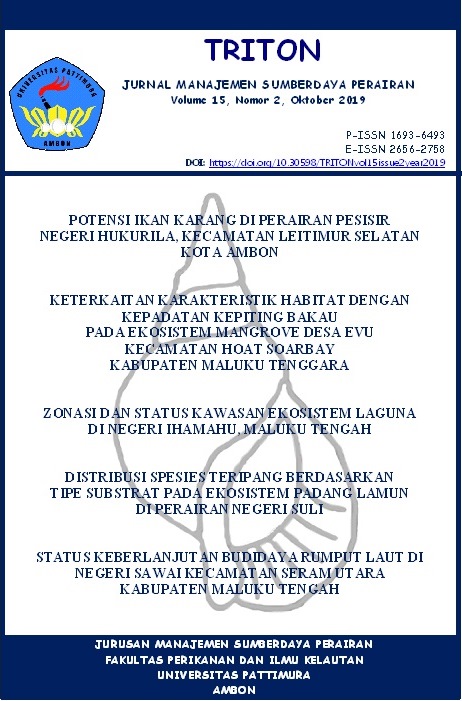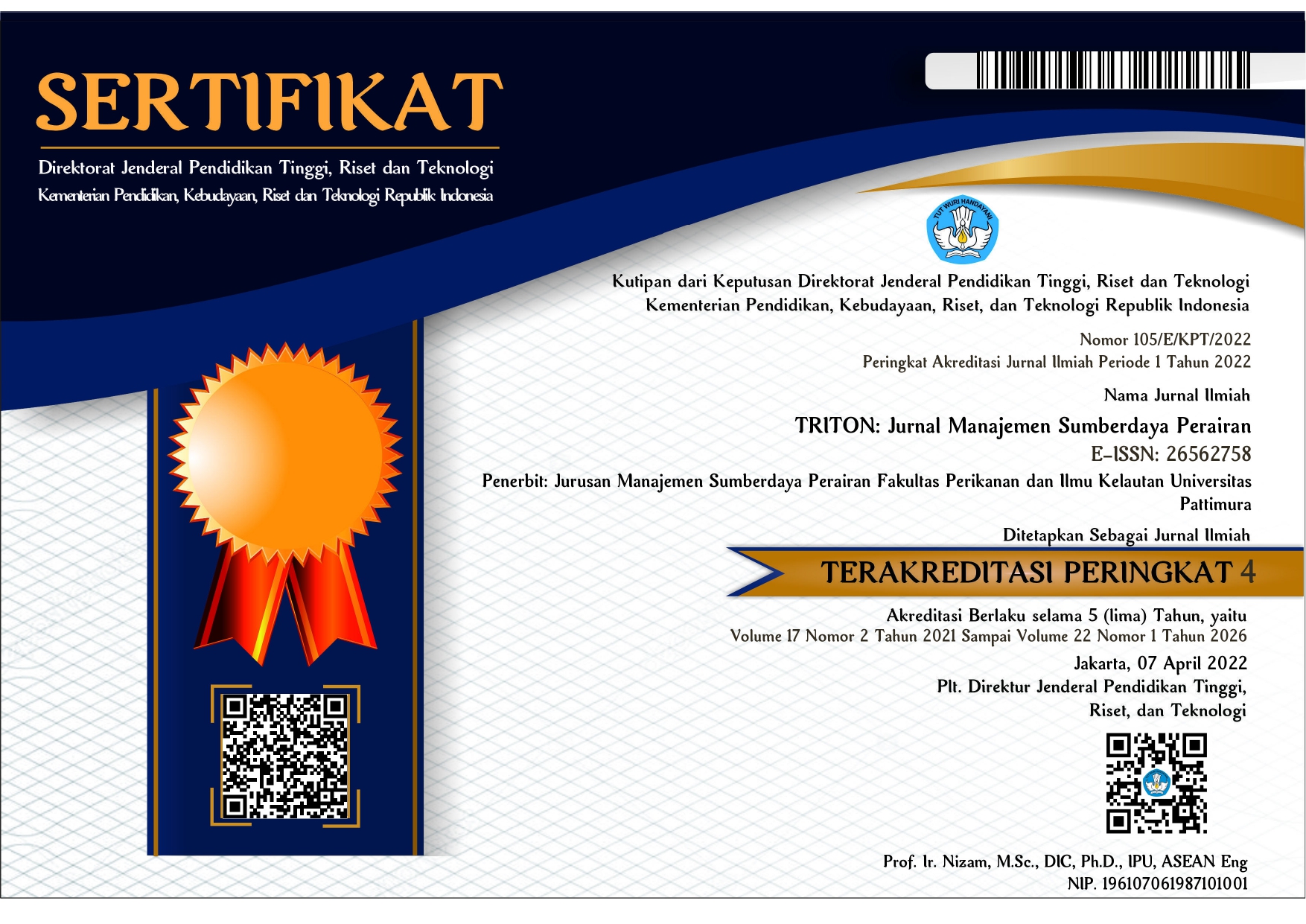DISTRIBUSI SPESIES TERIPANG BERDASARKAN TIPE SUBSTRAT PADA EKOSISTEM PADANG LAMUN DI PERAIRAN NEGERI SULI
Abstract
This study aims to determine the distribution of sea cucumber based on the characteristics of the substrate in the intertidal waters of Suli. This research was conducted in the waters of Suli in November 2017. Substrate data were analyzed and classified based on Shepards Scale, while the data of sea cucumber were obtained from previous study where samples were analyzed in the laboratory to identify the species based on the shapes of holothurians spicules, microscopically. The data were combined to plot the distribution of sea cucumber based on existing substrate characters. Data were analyzed descriptively. Approximately 14 species identified were scattered on various types of substrate. The substrate were dominated by sandy substrate, varied from medium sand, very coarse sand (dominant), coarse sand, gravel mixed with fine sand, and coral fragments. The result showed that a number of sea cucumbers species were spoted on certain substrates, however, lots of species habitually distributed on each type of substrate. Spesies of Holothuria scabra, H. atra, and Opheodosoma grisea were distributed at majority substrates types.
ABSTRAK
Penelitian ini bertujuan untuk mengetahui penyebaran teripang berdasarkan karakteristik substrat yang ada di perairan intertidal Suli. Penelitian ini dilakukan di perairan Suli pada bulan November 2017. Data substrat yang diperoleh dianalisa dan diklasifikasikan berdasarkan Skala Shepards. Sedangkan data teripang diperoleh dari penelitian sebelumnya, dimana sampel teripang yang diperoleh kemudian dianalisa pada laboratorium untuk mengidentifikasi spesies yang ditemukan, berdasarkan analisa bentuk spikula secara mikroskopis. Data dipadukan untuk digunakan dalam membuat peta distribusi teripang berdasarkan karakter substrat yang ada. Data dianalisa secara deskriptif. Teridentifikasi 14 spesies teripang pada ekosistem padang lamun perairan Suli yang tersebar pada berbagai jenis substrat. Tipe substrat pada lokasi penelitian didominasi oleh susbtrat berpasir, dengan variasi substrat antara lain: pasir bercampur pasir sedang, pasir bercampur pasir kasar, pasir kasar bercampur pasir, kerikil bercampur pasir halus, dan karang/patahan karang. Dari beberapa variasi ini, tipe substrat yang paling mendominasi adalah pasir kasar bercampur pasir. Hasil penelitian menunjukkan bahwa ada penyebaran beberapa jenis teripang pada substrat tertentu, namun sebagian besar jenis teripang terdistribusi secara merata pada setiap jenis substrat. Jenis teripang Holothuria scabra, H. atra, dan Opheodosoma grisea ditemukan pada hampir semua tipe substrat.
Kata Kunci: teripang, substrat, distribusi, ekosistem lamun, Suli
Downloads
References
Agudo, N., 2006. Sandfish Hatchery techniques. Australian Centre for International Agricultural Research (ACIAR), the Secretariat of the Pacific Community (SPC) and the WorldFish Center.
Arakawa, A.Y. 1990. A Handobook on the Japanese Sea Cucumber – Its Biology, Propagation and Utilization. Midori-Shobo Publishers. Tokyo.
Darsono, P. 2007. Teripang (Holothuroidea): Kekayaan Alam Dalam Keragaman Biota Laut. Oseana 32 (2): 1-10.
Hammond, L. S. 1983. Nutrition of Deposit-Feeding Holothuroids and Echinoids (Echinodermata) from a Shallow Reef Lagoon, Discovery Bay, Jamaica. Marine ecology Progress Research 10: 297-305.
Hartati, R., Widianingsih, D. Pringgenis. 2005. Teknologi Penyediaan Pakan bagi Teripang Putih (Holothuria scabra). Laporan Kegiatan Program Hibah Bersaing. Dibiayai oleh Direktorat Jendral Pendidikan Tinggi Departemen Pendidikan Nasional sesuai Surat Perjanjian Pelaksanaan pekerjaan Penelitian No. 031/SPPP/PP/DP3M/IV/200 Tanggal 11 April 2005.
Hartati, R., Widianingsih, Trianto, A., Zainuri, M., Ambariyanto. 2017. The Abundance of Prospective Natural Food for Sea Cucumber Holothuria atra at Karimunjawa Island Waters, Jepara, Indonesia. Biodiversitas. https://doi.org/10.13057/biodiv/d180311.
James, D.B., 1994. Ecology of Commercially Important Holothurians of India. Bulletin Central Marine Fisheris Research Institution 46: 37-38.
James, D.B., M.E. Rajapandian, C.P. Gopinathan, B.K. Baskar. 1994. Breakthrough in Induced Breeding and Rearing of the Larvae and Juveniles of Holothuria (Metriatyla) scabra Jaeger at Tuticorin. Bulletin Central Marine Fisheris Research Institution 46: 66-70.
Lawrence, J. 1987. A functional biology of echinoderms. The Johns Hopkins University Press. Baltimore. 340 pp.
Manuputty, G. D., M. M. Pattinasarany, G. V. Limmon, A. Luturmas. 2019. Diversity and abundance of Sea Cucumber (Holothuroidea) in Seagrass Ecosystem at Suli Village, Maluku, Indonesia. 2019 IOP Conf. Ser.: Earth Environ. Sci. 339 012032
Massin, C., 1999. Reef-dwelling Holothuroidea (Echinodermata) of the Spermonde Archipelago (South-West Sulawesi, Indonesia). Zool. Verh. Leiden 329:1-144.
Mercier, A., S.C. Battaglene and J-F. Hamel. 1999. Daily Burrowing Cycle and Feeding Activity of Juvenile Sea Cucumbers Holothuria scabra in Response to Environmental Factors. Journal of Experimental Marine Biology and Ecology, 239: 125–156
Pattinasarany, M. M. & G. D. Manuputty. 2018. Potensi Jenis Teripang Bernilai Ekonomis Penting di Ekosistem Padang Lamun Perairan Desa Suli Maluku Tengah. Jurnal PAPALELE 2(1): 1-7. ISSN 2580-0787.
Purcell, S.W. 2010. Diel Burying by the Tropical Sea Cucumber Holothuria scabra: Effects of Environmental Stimuli, Handling and Ontogeny. Marine Biology 157: 663-671.
Purcell, S. W., Hair, C. A., & Mills, D. J. 2012a. Sea Cucumber Culture, Farming and Sea Ranching in the Tropics: Progress, Problems and Opportunities. In Aquaculture. https://doi.org/10.1016/j.aquaculture.2012.08.053
Purcell, S.W., Y. Samyn, & C. Conand. 2012b. Commercially Important Sea Cucumbers of the World. FAO Species Catalogue for Fishery Purposes. No. 6. Rome, FAO. 2012. 150 pp.
Silaen, D. B., I. W. Arthana, S. A. Saraswati. 2018. Distribusi Teripang (Holothuroidea) pada Perairan Pesisir Nusa Lembongan, Kecamatan Nusa Penida, Kabupaten Klungkung, Bali. Journal of Marine and Aquatic Science 4(2): 263-270.
Sujarta, P & E. Indrayani. Pengetahuan Masyarakat Lokal Tentang Keragaman Teripang dan Pemanfaatannya di Pesisir Tablasupa, Depapre, Kabupaten Jayapura, Papua. Jurnal Biologi Papua 8(2):62-67. E-ISSN: 2503-0450.
Sulardiono, B. 2016. Potensi Pemanfaatan Teripang (Holothurians) di Perairan Karimunjawa, Kabupaten Jepara, Provinsi Jawa. BULETIN OSEANOGRAFI MARINA. https://doi.org/10.14710/buloma.v5i1.11298.
Wolkenhauer, S. M. 2008. Burying and Feeding Activity of Adult Holothuria scabra (Echinodermata: Holothuroidea) in a Controlled Environment. SPC Beche-de-mer Information Bulletin 27:25-28.
Zamora, L. N. and A. G. Jeffs. 2011. Feeding, Selection, Digestion and Absoption of Organic Matter from Mussel Waste of Juveniles of the Deposit-feeding Sea Cucumber Australostichopus mollis. Aquaculture 317: 223-228.
Zhou, L., H. Yang, S. Liu, X. Yuan, Y. Mao, Y. Liu, X. Xu and F. Zhang. 2006. Feeding and Growth on Bivalve Biodeposit by the Deposit Feeder Stichopus japonicus Selenka (Echinodermata: Holothuroidea) co-cultured in lantern net. Aquaculture 256: 510-520.


1.png)










